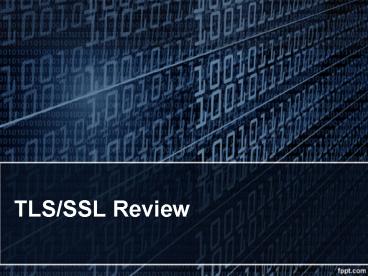TLS/SSL Review PowerPoint PPT Presentation
1 / 18
Title: TLS/SSL Review
1
TLS/SSL Review
2
Transport Layer SecurityA 30-second history
- Secure Sockets Layer was developed by Netscape in
1994 as a - protocol which permitted persistent and secure
transactions. In - 1997 an Open Source version of Netscapes
patented version - was created, which is now OpenSSL. In 1999 the
existing - protocol was extended by a version now known as
Transport - Layer Security (TLS). By convention, the term
"SSL" is used - even when technically the TLS protocol is being
used.
3
TLS Server Certificate
- Authentication
- Server and/or client identity is verified via
certificate. - Privacy
- Data is encrypted with block cipher
- Cipher key is exchanged via public key
4
TLS Server Certificate Verification
- The client browser recognizes the Certificate
Authority and thus verifies the authenticity of
the connection.
5
Failed Verification
- If there is a conflict between the name on the
certificate and the name of the server, the
browser pops up a Domain Name Mismatch notice,
allowing the user to decide whether to continue.
6
Cert Request CSR
- CSR Certificate Signing Request
- It contains
- Information about the organization (organization
name, country, etc...) - Web Server's public key
- A unique mathematical match to server's private
key .
7
Cert Request CSR (cont.)
- Lets Create one
8
Cert Request
- Go to http//security.sdsu.edu/services/ssl/
- Common Name ricardoserver.sdsu.edu
- Server software
- Certificate Term 1,2, or 3 years
- CSR 2048-bit CSR
- Pass-phrase (Dont use)
9
Cert Request
10
Cert Request Type
Certificate Type Description Purpose
Single domain (Incommon SSL Certificate) SSL certificate protects a single domain e.g. www.sdsu.edu. These are the "traditional" SSL certificates that have been in use since the advent of the SSL protocol.
Multiple domain (Incommon Multi-domain SSL certificate) A multiple domain certificate allows you protect multiple host names with a single SSL certificate. These are also known as SAN (Subject Alternative Name) certificates. Up to 100 domain names can be included in a multi-domain certificate. These certificates are often used on a single servers hosting many web sites to eliminate the need to use unique IP addresses for each web site e.g. www.sdsu.edu and www.ba.sdsu.edu.
11
Cert Request Type (cont.)
Certificate Type Description Purpose
Wildcard (Incommon wildcard SSL certificate) A wildcard certificate protects a domain and unlimited subdomains of that domain e.g. (not used for sdsu.edu)
UCC Exchange (Incommon Unified Communications Certificate) A unified communications certificate allows you to protect multiple host names with a single SSL certificate. Specifically designed for Microsoft Exchange and Microsoft Office Communications Server. Newer versions of Microsoft products will work with multi-domain certificates.
12
Cert Request Type (cont.)
Certificate Type Description Purpose
Extended validation single domain (Comodo EV SGC SSL certificate) An Extended Validation certificate protects a single domain e.g. my.sdsu.edu. However, the certificate is issued according to a specific set of identity verification criteria. Certificates issued by a CA under the EV guidelines are not structurally different from other certificates but are designated with a CA-specific policy identifier so that EV-aware software (browsers) can recognize them and display the "green bar".
Extended validation multiple domain (Comodo EV multi-domain SSL certificate) See above, except this certificate can protect multiple domains.
13
Cert Request Email
- Hello,You have successfully enrolled for an
InCommon SSL certificate.You now need to
complete the following steps Click the
following link to download your SSL certificate
(generally try to use a version that includes
intermediates root or your certificate may be
rejected by some older clients) Format(s)
most suitable for your server software as
X509 Certificate only, Base64 encoded https//cer
t-manager.com/customer/InCommon/ssl?actiondownloa
dsslIdxxxxformatx509CO as X509
Intermediates/root only, Base64
encoded https//cert-manager.com/customer/InCommo
n/ssl?actiondownloadsslIdxxxxformatx509IO
as X509 Intermediates/root only Reverse,
Base64 encoded https//cert-manager.com/customer/
InCommon/ssl?actiondownloadsslIdxxxxxformatx5
09IOR Other available formats as
PKCS7 Base64 encoded https//cert-manager.com/cu
stomer/InCommon/ssl?actiondownloadsslIdxxxxxxf
ormatbase64 as PKCS7 Bin
encoded https//cert-manager.com/customer/InCommo
n/ssl?actiondownloadsslIdxxxxxformatbin
as X509, Base64 encoded https//cert-manager.c
om/customer/InCommon/ssl?actiondownloadsslIdxxx
xxxformatx509
14
Cert Request Email
- Which File to download?
- X509 Certificate only, Base64 encodedThis file
contains only your domain/entity certificate and
is commonly used with Apache-based systems
(Apache Directive SSLCertificateFile), Tomcat
and Oracle Wallet Manager. - X509 Intermediates/root only, Base64 encodedThis
file includes only the Root and Intermediate CA
certificates (in order) for your domain/entity
certificate. - X509 Intermediates/root only (Reverse), Base64
encodedThis file contains only the
Intermediate(s) and Root CA certificates (in
reverse order) and is commonly used with
Apache-based systems (Apache2 Directive
SSLCertificateChainfile). This file is also known
as a 'CA Bundle' or 'Certificate Chain
File'. Other available formats - PKCS7 Base64 encoded
- PKCS7 Bin encodedPKCS7 is commonly used with
IIS 5.x and later. This file contains the Root,
Intermediate(s) and your certificate all rolled
into a single file. - X509, Base64 encodedThis file typically includes
(in order) Root, Intermediate(s) and your
certificate.
15
Cert Request Email
- PKCS7 vs. X509?
- PKCS7 is a cryptography standard published by
RSA Security in 1993 that deals with data that
has cryptography applied to it. Its a standard
for how to package data securely. PKCS7
references the X.509 standard, as the source for
certificate formatting. - X.509 is a wide ranging security standards
document published in 1998 which includes amongst
other things, certificate file formats. - X.509 specifies that certificates should be
encoded using the Distinguished Encoding Rules of
the ASN.1 (documented in the X.208 and now X.608)
standard, first published in 1984. - So, DER says how to encode some strings and
numeric source data into a binary format, X.509
says which data needs to go into a digital
certificate, and PKCS7 says how that certificate
should be used, to digitally sign a message.
16
SSL Cert Install
- Add to httpd.conf
- SSLEngine on
- SSLCertificateKeyFile /etc/ssl/ssl.key/server.key
- SSLCertificateFile /etc/ssl/ssl.crt/yourDomainName
.crt - SSLCertificateChainFile /etc/ssl/ssl.crt/yourDomai
nName.ca-bundle - Restart apache
17
SSL Cert Expr. Monitoring
- Nagios
- Bash Script http//prefetch.net/code/ssl-cert-ch
eck
18
SSL Cert
- Thank you
- Questions
- Email me at rfitipal_at_mail.sdsu.edu

